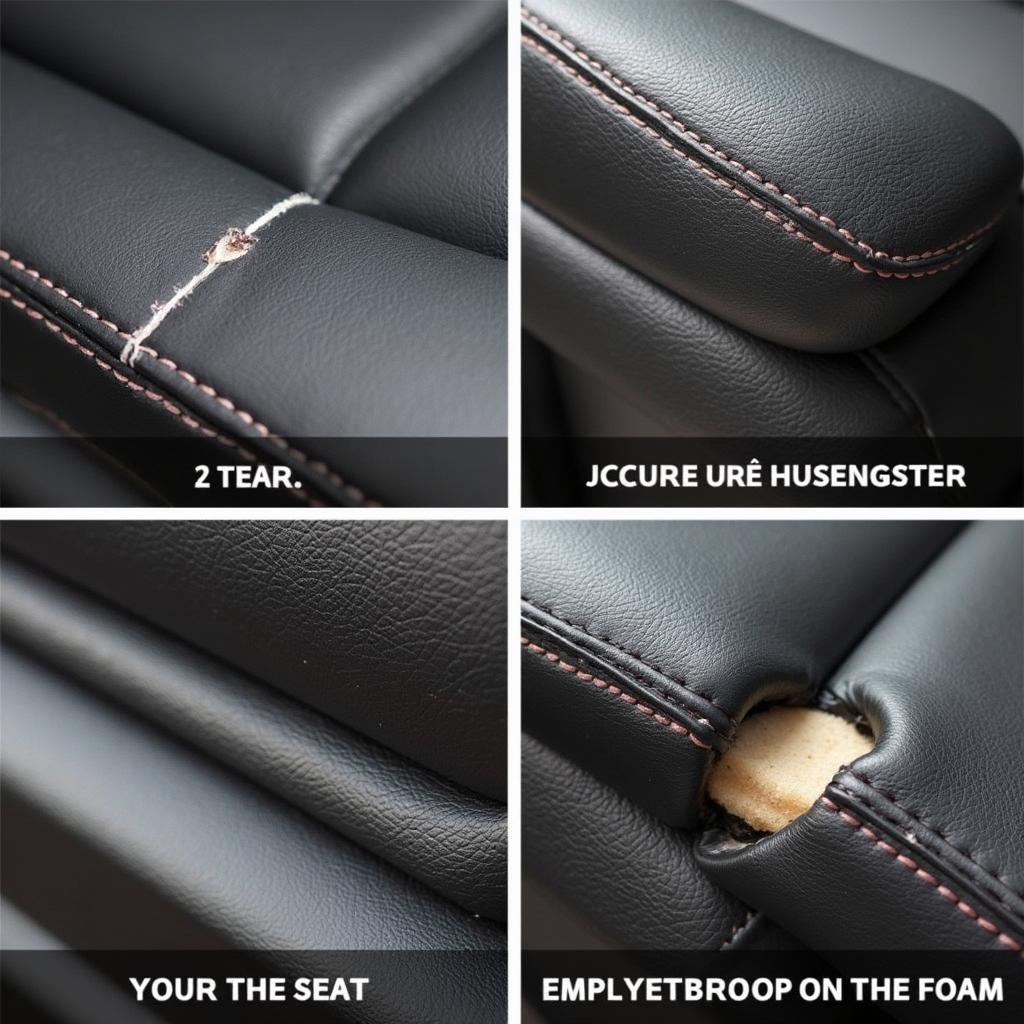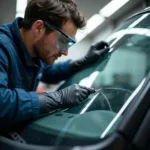Torn leather car seats can be an eyesore, diminishing the overall look and feel of your vehicle’s interior. The good news is that you don’t always have to shell out a fortune for professional repairs. This guide will walk you through the steps on how to repair torn car seat leather, helping you restore your car’s interior and potentially save money in the process.
Assessing the Damage: Is DIY Repair Possible?
Before diving into the repair process, it’s important to assess the severity of the damage. Minor cracks and tears can often be tackled with DIY methods, while extensive damage may require professional intervention.
Consider these factors:
- Size of the tear or crack: Small tears are easier to repair than large gashes.
- Location of the damage: Tears on seams or high-stress areas might be more complex.
- Depth of the damage: Surface scratches are simpler to fix compared to deep cuts that expose the underlying foam.
Gathering Your Leather Repair Supplies
Once you’ve determined that DIY repair is feasible, gather the necessary supplies:
- Leather Cleaning Agent: Opt for a dedicated leather cleaner to remove dirt and grime effectively.
- Leather Repair Kit: These kits typically contain a color-matched filler compound, adhesive, a spatula, and a grain paper for texture matching.
- Rubbing Alcohol: Used for cleaning and prepping the damaged area.
- Microfiber Cloths: Essential for cleaning and applying products.
- Scissors: For trimming any loose threads or leather pieces.
- Hair Dryer (optional): Helpful for speeding up the drying process of certain repair compounds.
Step-by-Step Guide to Repairing Torn Car Seat Leather
Follow these steps to repair your torn car seat leather:
-
Clean the Area: Thoroughly clean the damaged area and its surroundings using a leather cleaning agent and a microfiber cloth. Allow it to dry completely.
-
Trim Loose Edges (if necessary): If there are any loose threads or frayed leather pieces, carefully trim them using scissors.
-
Apply the Leather Filler: Using the spatula from your leather repair kit, carefully apply the filler compound to the tear or crack. Ensure the filler fills the damaged area evenly and slightly overlaps the edges.
-
Texturize the Filler (if necessary): Some leather repair kits include a grain paper. If yours does, press the grain paper onto the wet filler and apply light pressure to imprint a texture that matches the surrounding leather.
-
Allow to Dry Completely: Let the filler dry thoroughly. Refer to the instructions provided with your leather repair kit for drying times. You can use a hairdryer on a low heat setting to expedite the process if desired.
-
Apply Leather Adhesive (if necessary): For deeper tears, your repair kit might include a leather adhesive. Apply a thin layer to the underside of the torn leather flap and carefully press it down onto the filler. Hold in place for the recommended time.
-
Clean and Condition: Once the repair is complete and dry, clean the area again with a leather cleaner and apply a leather conditioner to restore the leather’s suppleness and protect it from future damage.
Tips for a Seamless Repair
- Color Matching is Key: Choose a leather repair kit that closely matches the color of your car seats for a less noticeable repair. You might need to blend two or more colors to achieve the perfect match.
- Practice Makes Perfect: If you’re unsure about your skills, practice on a hidden area of the car seat or a similar piece of leather before tackling the visible damage.
- Patience is a Virtue: Take your time with each step of the repair process, ensuring the filler is applied evenly and allowed to dry completely for optimal results.
When to Consult a Professional
While DIY repairs can be effective for minor damage, there are situations where seeking professional help is advisable. Consider consulting a professional for:
- Extensive Damage: Large tears, deep cuts, or damage to multiple areas of the car seat are often best left to professionals.
- Damage to Seams or High-Stress Areas: Repairs in these areas require specialized knowledge and techniques to ensure the repair holds up over time.
- Lack of Confidence: If you’re unsure about your ability to achieve a satisfactory repair, it’s always a good idea to consult a professional.
Conclusion
Repairing torn car seat leather can be a rewarding DIY project, potentially saving you money and restoring your car’s interior. By following the steps outlined in this guide, you can tackle minor tears and cracks effectively. Remember to assess the damage carefully, gather the necessary supplies, and approach the repair with patience and attention to detail. If you’re ever in doubt, don’t hesitate to consult a professional for assistance.
Frequently Asked Questions (FAQs)
Can I use super glue to repair torn leather car seats?
It’s not recommended to use super glue as it can create a stiff and noticeable repair. Leather repair kits are specifically designed for this purpose and offer better flexibility and color matching.
How long does it take for leather filler to dry?
Drying times vary depending on the type of filler and environmental conditions. Refer to the instructions provided with your leather repair kit for specific drying times.
Can I sit on my car seat immediately after the repair?
It’s best to allow the repair to cure completely before sitting on the seat. This typically takes at least 24 hours, but it’s always recommended to follow the manufacturer’s instructions.
How do I prevent future tears in my leather car seats?
Regular cleaning and conditioning of your leather seats can help prevent drying, cracking, and tearing. You can also use seat covers to protect your leather seats from wear and tear.
Where can I find leather repair kits?
Leather repair kits are available at most auto parts stores, online retailers, and some department stores.
What if the tear in my car seat is too large to repair myself?
For extensive damage or if you’re not comfortable attempting the repair yourself, it’s best to consult a professional car upholstery repair shop.
Do leather repair kits work on all types of leather?
Most leather repair kits are designed for use on finished leather, which is the most common type of leather used in car seats. However, it’s always best to check the product label to ensure compatibility with your specific type of leather.
If you have any further questions or need assistance with your car seat repair, feel free to contact us via WhatsApp at +1(641)206-8880 or email us at [email protected]. Our dedicated customer support team is available 24/7 to assist you. For more helpful tips and guides on car repair and maintenance, browse our comprehensive collection of articles on CarRepairOnline.



